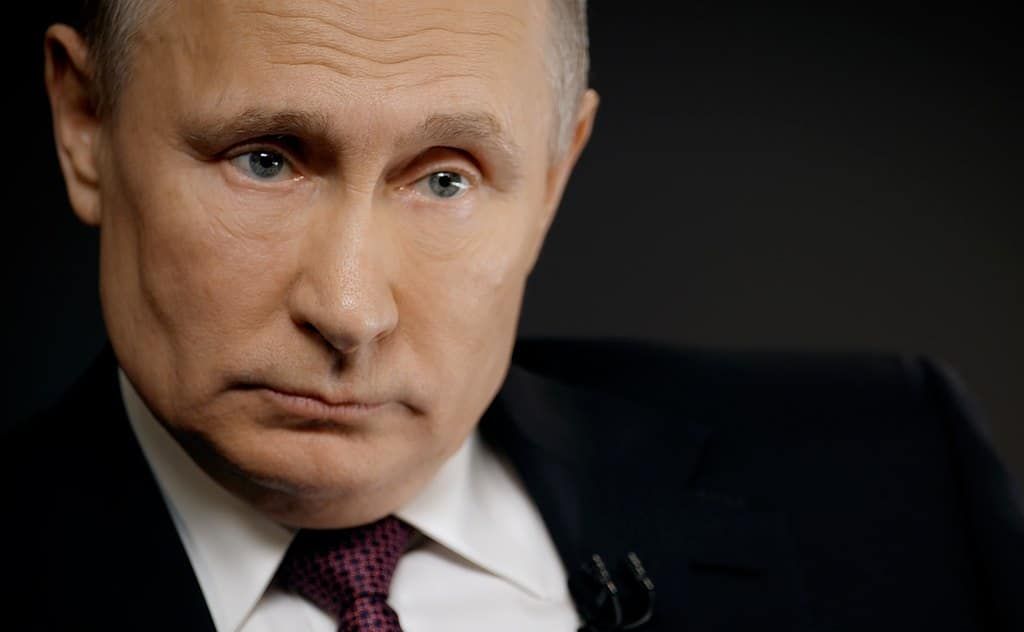Putin’s nuclear warnings: heightened risk or revolving door?
By Stephen J. Cimbala, Lawrence J. Korb | March 28, 2024
 Russian President Vladimir Putin. Credit: TASS News Agency. Accessed via Wikimedia Commons. CC BY 4.0.
Russian President Vladimir Putin. Credit: TASS News Agency. Accessed via Wikimedia Commons. CC BY 4.0.
In his State of the Nation address February 29, Russian President Vladimir Putin issued one of his most explicit warnings about the danger of nuclear war in Ukraine and noted that Russian strategic nuclear forces “are in a state of full readiness” and able to hit targets in the West. In addition, Russian military files from 2008 to 2014—leaked recently to the Financial Times—seem to suggest that Russia’s threshold for nuclear first use is lower than Western military experts had assumed. Some 29 classified Russian military documents include discussions of war gaming and reportedly identify operational thresholds for the first use of so-called tactical or non-strategic nuclear weapons. Commenting on the unusal dump of secret Russian documents, Alexander Gabuev, director of the Carnegie Russia Eurasia Center in Berlin, said: “They show that the operational threshold for using nuclear weapons is pretty low if the desired result can’t be achieved through conventional means.”[1]
Coming on the heels of a suggestion by French President Emmanuel Macron that the option of sending NATO ground forces into Ukraine was under discussion within the alliance, the leaked documents on Russian nuclear first use seem both timely and significant.[2] On the other hand, in previous statements about Russian military doctrine for deterrence and possible nuclear employment, many Russian officials have stressed that nuclear weapons would only be used in response to a nuclear attack on Russia or its allies, or in cases of threat to the survival of the regime and nation posed by a war with conventional weapons. In response to the leaked documents, a Putin spokesperson commented: “The main thing is that the threshold for the use of nuclear weapons is absolutely transparent and is spelled out in the doctrine. As for the documents mentioned, we strongly doubt their authenticity.”
Regardless of the authenticity of these documents, references to the possibility of Russian nuclear first use in Ukraine cannot be treated as idiosyncrasies or departures from precedent. Putin himself has, on numerous occasions since the beginning of Russia’s war against Ukraine in February 2022, reminded NATO and the world that the nuclear option remains available should Russia choose to use it. He has also noted, in this regard, Russia’s superior numbers of non-strategic or tactical nuclear weapons compared to the US tactical nuclear weapons deployed in other NATO countries.[3]
Observers of varying backgrounds have put forward explanations for Putin’s saber rattling, all of which suggest the Russian president hopes, through nuclear threats, to achieve some current or future tactical edge in his country’s continuing face-off with Ukraine, the United States, and NATO. All that reasoning, however, cannot erase the dangerous reality: Any Russian first use of tactical nuclear weapons would create unprecedented conditions that could easily lead not to a regional Russian advantage, but to a wider nuclear war that would decimate Russia and its leadership (not to mention the rest of the world).
Why is Russia making nuclear threats? Since the Russian invasion of Ukraine in 2022, a variety of commentators have put forward at least five explanations for Putin’s propensity for nuclear saber rattling. First, some contend that Putin is bluffing. This is the argument of Ukrainian President Volodymyr Zelensky, among others. Zelensky feels that Putin’s nuclear diplomacy is designed to intimidate NATO into backing off from its support for Ukrainian sovereignty and independence. Others in and outside of Ukraine are more fearful of attacks with conventional weapons on Ukrainian nuclear power plants—and the residual effects of such strikes on public health, infrastructure and climate—than an actual Russian nuclear first use.
A second explanation for Putin’s nuclear threats is that they constitute a probe. Russian leadership is, as it were, taking the temperature of the United States and NATO, to see their reactions. This presents a dilemma for American and NATO European leaders. If they overreact to Putin’s intimidation, they appear fearful and potentially vulnerable to nuclear blackmail. If they simply ignore his comments about nuclear war, they may come across as lacking in awareness of the risks of escalation as fighting continues.
A third perspective on Putin’s nuclear rhetoric sees it as a response to Russia’s political and military setbacks since the war began in February, 2022. The initial objective of Russia’s so-called Special Military Operation was the prompt defeat of the Ukrainian armed forces and the abdication or surrender of its government, replaced by a Russian puppet regime. Instead, Russia found itself bogged down in a protracted war that has been extremely costly in both personnel and resources—hence the threat of nuclear weapons use, if the situation worsened. Putin has been dissatisfied with the performance of Russian armed forces on more than one occasion, and the weird attempt at a putsch by the erstwhile Wagner group created a temporary sense of chaos in the military chain of command. Wagner has since been scattered to the winds, and Russia’s military position relative to Ukraine has improved in the aftermath of the failed Ukrainian counteroffensive of the summer and the fall of 2023. Moreover, Russia’s superior numbers of available and potential military personnel and war-supporting industrial resources, relative to those of Ukraine, create the potential for an endless stalemate with outcomes favorable to Russia. But the situation remains uncertain, and so the nuclear saber-rattling continues.
A fourth perspective on Putin’s nuclear diplomacy asserts that he is laying the predicate for escalation to nuclear first use if unexpected battlefield reverses threaten to destabilize Russia’s operational-tactical position for the defense of important objectives. NATO support for Ukraine provides that county not only with military hardware such as tanks, armored personnel carriers, long range missiles and antimissile systems, and the like, but also with the “software” of warfare, including C4ISR (command, control, communications, computers, intelligence, surveillance and reconnaissance) assistance with navigation, warning, special operations, and strategic deception. On more than one occasion, Ukrainian brainpower has outmaneuvered Russian muscle. But the Russians are learning fast and have upped their game significantly since the embarrassing blunders of 2022. Moreover, Russian armed forces have demonstrated in training exercises superior understanding of the extreme complexity of modern airland battle and its potential risks and costs. They are also aware of the difficulties in operational-tactical maneuver on a nuclear battlefield.[4]
A fifth possible interpretation of Putin’s propensity for nuclear rhetoric is that it reflects the reasoning of some Russian military and political thinkers about the management of escalation toward favorable outcomes by the manipulation of risk. According to this line of reasoning, nuclear first use is one point on a continuum of coercion that extends from the lowest point on the conflict spectrum up to the crossing of the threshold from conventional into nuclear war. Prominent Russian analyst Sergei Karaganov’s essay, “A Difficult but Necessary Decision,” argued that a Russian tactical nuclear first use somewhere in Europe might be necessary to shock NATO back into its senses and concede to Russia’s view of the situation in Ukraine.
Still, it is clear that many experts within Russia are not aligned with Karaganov’s high-octane nuclear chest-thumping. For example, Ivan Timofeev, director general of the Russian International Affairs Council and a widely published academic, noted that Karaganov’s approach “underestimates the Western elites’ determination to climb the escalation ladder with Russia, and, if necessary, ahead of it” and “overlooks the possibly catastrophic consequences for Russia itself.” According to noted military theorist Dmitry Adamsky, Russia offers a cross-domain cocktail of conventional war-fighting and nuclear deterrence options. Crossing the nuclear threshold would most likely occur when Russia felt that its nonnuclear escalation options had been exhausted and its nuclear rhetoric had thus far proved futile. Even then, prior to actual nuclear first use, a “muscle-flexing” phase of gradually increasing “strategic gestures” will be used to communicate resolve and capability to climb the escalation ladder, Adamsky writes.
The limits of nuclear threats. The preceding discussion focuses on a Russian decision for conventional war or nuclear escalation without reference to the possibility of a Russian-Chinese coordination of tactics and strategy in regional wars. US deterrence and defense requirements for a simultaneous Russian and Chinese regional aggression assume a greater need for forward-deployed forces and power-projection capabilities than hitherto.[5] The final report of the Congressional Commission on the Strategic Posture of the United States warned that US objectives must include “effective deterrence and defeat of simultaneous Russian and Chinese aggression in Europe and Asia using conventional forces” and that, if existing conventional forces were inadequate to this objective, US strategy would have to be adjusted to increase reliance on nuclear weapons “to deter opportunistic or collaborative aggression” in the other theater.[6]
One should be cautious, however, in estimating the sizes and capabilities of future Russian and Chinese nuclear forces. Nor can it be assumed that the current rapprochement between Russia and China will be everlasting or apply to all issues of military significance. China and Russia have a history of border conflicts and Cold War disagreements, and China’s world historical view is somewhat apart from Russia’s.
William Alberque, director of strategy, technology and arms control at the International Institute for Strategic Studies think tank, has provided a concise description of the possible roles for non-strategic nuclear weapons in Russian military strategy: “deterring unwanted conflicts; coercing adversaries; shaping the battlefield for planned conflicts; controlling escalation within conflicts to protect the Russian homeland; preventing outside powers (read: the United States) from intervening in its conflicts; and ensuring that it prevails in war.”
Notwithstanding the rationale, the decision to move from nuclear deterrence to nuclear first use in Europe or Asia would be a world-historical marker—and not one of progress. The firebreak between non-strategic and strategic nuclear warfare has never been tested under exigent conditions, and indeed, part of the deterrent efficacy for tactical nuclear weapons lies in their potential coupling to strategic nuclear war. Putin’s assertive nuclear rhetoric is strategically unhelpful and politically dangerous.
Notes
[1] Gabuev, cited in Max Seddon and Chris Cook, “Leaked Russian military files reveal criteria for nuclear strike,” Financial Times, February 28, 2024, in Johnson’s Russia List 2024 – #51 – February 29, 2024
[2] Anatol Lieven and George Beebe, “Europeans’ last ditch clutch at Ukrainian victory: France’s Macron raised the idea of Western troops entering the fray, others want to send longer range missiles. It’s all folly.”, Responsible Statecraft, February 28, 2024, in Johnson’s Russia List 2024 – #51 – February 29, 2024
[3] Hans M. Kristensen, Matt Korda, and Eliana Johns, Bulletin of the Atomic Scientists, Nuclear Notebook: Russian Nuclear Weapons: 2023, May 9, 2023, https://thebulletin.org/premium/2023-05/nuclear-notebook-russian-nuclear-weapons-2023/
[4] Dr. Lester W. Grau and Charles K. Bartles, The Russian Way of War: Force Structure, Tactics, and Modernization of the Russian Armed Forces (Ft. Leavenworth, Kansas: Foreign Military Studies Office, 2016), pp. 201-203 and 206.
[5] The White House, National Security Strategy (Washington, D.C.: October, 2022), pp. 23-26.
[6] Madelyn R. Creedon, Chair, and Jon L. Kyl, Vice Chair, America’s Strategic Posture: The Final Report of the Congressional Commission on the Strategic Posture of the United States (Washington, D.C.: October 2023), p. xiii.
Together, we make the world safer.
The Bulletin elevates expert voices above the noise. But as an independent nonprofit organization, our operations depend on the support of readers like you. Help us continue to deliver quality journalism that holds leaders accountable. Your support of our work at any level is important. In return, we promise our coverage will be understandable, influential, vigilant, solution-oriented, and fair-minded. Together we can make a difference.
Keywords: Macron, Putin, Russian nuclear doctrine, nuclear saber-rattling, nuclear threats
Topics: Analysis, Nuclear Risk, Nuclear Weapons
















Excellent, timely, disturbing article and analysis. I agree with your conclusion: “Putin’s assertive nuclear rhetoric is strategically unhelpful and politically dangerous.” This article also makes me think of what we learned about secret U.S. threats to use tactical nuclear weapons during the Vietnam war. My PBS American Experience documentary, The Movement and the “Madman,” explores President Nixon’s “madman strategy” and his and Kissinger’s “nuclear diplomacy” in 1969 as a way to intimidate North Vietnam (and the Russians) and end the war on U.S. terms.
It’s a sad statement of desperation from Putin, to even consider the use of tactical nuclear weapons upon Ukraine, in order to win HIS war. A victory in his mind is only for self gratification, so to not be labeled a ‘loser’. He has so much in common with his ‘friend’, Donald Trump, who insults anyone who he classifies as a ‘loser’. Putin has never gotten over the 1991 breakup of old Soviet and the scramble for freedom and NATO membership by developing free countries like Ukraine. Does he have no clue that even a limited nuclear attack on Ukraine… Read more »
•on December 15, 1994, before the land mark 1995 NPT review, The General Assembly of the United Nation submitted a question to the Court for an advisory opinion. The UN resolution 49/75, submitted to the Court was adopted by 78 states voting in favor, 43 against, 38 abstaining and 26 not voting. According to resolution 49/75 K which set forth the following question;•“ Decide , pursuant to Article 96, paragraph 1, of the charter of the United Nation to request the International Court of Justice urgently to render its advisory opinion on the following question: “Is the threat or use of… Read more »
There’s an excellent new documentary series on Netflix which provides a history of the cold war as the back story to the current conflict in Ukraine. Here’s the trailer:
https://www.youtube.com/watch?v=qHuuLo-CSRo&t=40s
Most readers of this blog will already know the history. But the film can be quite instructional for younger people who didn’t live through the cold war and aren’t familiar with the details.
The article on this page seems very well informed too. But I’ll admit to having grown weary of an expert focus on details, because such a focus has never worked in solving the problem.